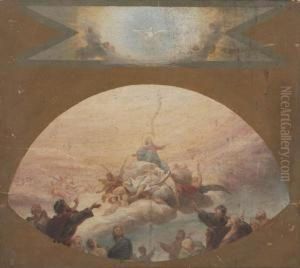Nobili Salvatore Paintings
Salvatore Nobili was an Italian painter, born in 1776 in Naples, Italy. He was primarily known for his work in the Neoclassical style, which was prevalent in Europe during the late 18th and early 19th centuries. This style sought to revive the aesthetics of classical antiquity, particularly those of Ancient Greece and Rome, and was characterized by simplicity, symmetry, and a sense of grandeur.
Nobili was active during a period of significant cultural and political change in Italy, which was then a patchwork of different states. His work was influenced by the shifting political landscape and the rise of Napoleonic power. Despite the lack of extensive documentation on Nobili's life compared to his more famous contemporaries, it is known that he received his artistic training in Naples, which was a major artistic center at the time, housing the Royal Academy of Fine Arts and other significant institutions.
During his career, Nobili worked on various religious and mythological subjects, which were common themes in Neoclassical art. He was skilled in the use of fresco and oil painting, and his works often reflected the Neoclassical ideals of harmony, clarity, and strong linear qualities. Nobili's paintings contributed to the cultural life of Naples and the surrounding region, and while he may not have achieved the same level of fame as artists like Jacques-Louis David or Antonio Canova, his contributions to Italian Neoclassicism were nonetheless valued by his contemporaries.
Salvatore Nobili passed away in 1830, leaving behind a legacy that would be appreciated by art historians and enthusiasts who study the Neoclassical movement. Although specific details of his life and works are not widely chronicled, Nobili's art remains a testament to the enduring influence of classical antiquity on European art and the rich tapestry of Neoclassical painting in Italy.
